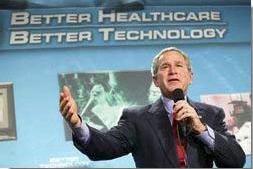Nationalized Medical Records on the Internet
~ The End of Privacy ~
Nationalization of medical records is a critical first step
to a national health care system. And if a national
health care system isn’t the purpose, then what is?
Background
In 1990, Senator John Glenn, Chairman of the Governmental Affairs Committee made a request of the GAO to study the potential benefits of automation of medical records and the factors that would inhibit the implementation. In January of 1991, the GAO presented the results of their study to the Committee[2]:
Dear Mr. Chairman:
In response to your request of December 4,1990, we are reporting to you the results of our review of automated medical records. The report discusses the potential benefits that automation could make to the quality of patient care and the. factors that impede its use. We are making recommendations to the Secretary of Health and Human Services to support automated medical records as part of the Department’s mandate to conduct research on outcomes of health care services.
That paragraph gives the real reason behind the nationalization of medical records so no matter what else is said, the real reason for nationalized medical records is medical research. Initially, it was to analyze outcomes, but over time as we’ll see below, they’ve taken the slippery slope towards human medical research allegedly for disease prevention.
xxxxxxxxxxxxxxxxxxxxxxxxxxxxxxxxxxxxxxxxxxxxxxxxxxxxxxxxxxxx
On October 19, 1992, Health and Human Services Secretary Louis W. Sullivan, issued a press release[3] announcing:
HHS Secretary Louis W. Sullivan, M.D., today announced a series of new steps toward creating a nationwide electronic health care information network. He said major elements of the new system could be in place for Medicare and Medicaid within 15 months, producing significant savings in health costs.
In the new system, health care insurance and billing will be handled by computer networks, eliminating most paperwork. When fully implemented, Americans would carry a single "health card," similar to bank and credit cards, enabling access to their own insurance coverage information. Billing would be performed electronically, and consumers as well as health care providers would no longer have to complete extensive paper forms.
Ultimately, most patient records could also be maintained electronically and accessed with the patient's permission through the card and a PIN (personal identification number).
"My department is taking action today despite the failure of Congress to pass legislation which was submitted earlier this year to establish a nationwide electronic health information system," Dr. Sullivan said.
"It is our intention to act on our own and with the private sector in every area where we have authority to bring the new electronic network into being."
In January
of 1993 when Clinton announced the formation of his Task
Force on National Health Care Reform[4],
the GAO was already in the process of preparing another
report for the Chairman of the Senate Government Affairs
Committee. The report titled, “Automated Medical Records:
Leadership Needed to Expedite Standards Development”[5]
was published in April of 1993.
Excerpts from Executive Order 13335:
By the authority vested in me as President by the Constitution and the laws of the United States of America, and to provide leadership for the development and nationwide implementation of an interoperable health information technology infrastructure to improve the quality and efficiency of health care, it is hereby ordered as follows:
Sec. 2. Policy. In fulfilling its responsibilities, the work of the National Coordinator shall be consistent with a vision of developing a nationwide interoperable health information technology infrastructure that:
(a) Ensures that appropriate information to guide medical decisions is available at the time and place of care;
(d) Promotes a more effective marketplace, greater competition, and increased choice through the wider availability of accurate information on health care costs, quality, and outcomes;
(e) Improves the coordination of care and information among hospitals, laboratories, physician offices, and other ambulatory care providers through an effective infrastructure for the secure and authorized exchange of health care information; and(f) Ensures that patients' individually identifiable health information is secure and protected. (Ha!)
Sec. 3. Responsibilities of the National Health Information Technology Coordinator. (a) The National Coordinator shall, to the extent permitted by law, develop, maintain, and direct the implementation of a strategic plan to guide the nationwide implementation of interoperable health information technology in both the public and private health care sectors that will reduce medical errors, improve quality, and produce greater value for health care expenditures.
(iii) Evaluate evidence on the benefits and costs of interoperable health information technology and assess to whom these benefits and costs accrue;
(v) Not assume or rely upon additional Federal resources or spending to accomplish adoption of interoperable health information technology; and
(a) The Director of the Office of Personnel Management shall report within 90 days of this order on options to provide incentives in the Federal Employee Health Benefit Program that will promote the adoption of interoperable health information technology; and(b) Within 90 days, the Secretary of Veterans Affairs and the Secretary of Defense shall jointly report on the approaches the Departments could take to work more actively with the private sector to make their health information systems available as an affordable option for providers in rural and medically underserved communities.
* *
* * *
*
xxxxxxxxxxxxxxxxxxxxxxxxxxxxxxxxxxxxxxx
"Last year, the President
made the use of health information technology a key
principle of his health care agenda. On April 27, 2004, the
President signed Executive Order 13335 (EO) announcing his
commitment to the promotion of health information technology
to lower costs, reduce medical errors, improve quality of
care, and provide better information for patients and
physicians. In particular, the President called for
widespread adoption of interoperable electronic health
records (EHRs) within 10 years so that health information
will follow patients throughout their care in a seamless and
secure manner. This means that their medical information is
available to the right people at the right time, while
remaining protected and secure. The President has tasked HHS
with making this vision a reality by 2014. The goal can be
met, but there are major challenges to be faced, and the
path forward requires a concentrated nationwide effort to
achieve widespread adoption of interoperable EHRs."[6]
Mike
Leavitt, HHS
Clearly, the project was already in process beginning in the first Bush Administration. The only mistake the Clinton Administration seems to have made is that he put a lightening rod in charge of it - namely Hillary Clinton. But the National Automated Medical Records system was only one piece of a much larger project that would ultimately bring about the transformation of the United States and in fact, the world - but in this writer’s opinion, the transformation is not for the better because the dark side potential far outweighs the good.
As we know, there was such an uproar from the Republicans that Clinton's project for the health care system was dismantled, but the truth is that it continued - just without the high profile because the project was part of a much larger project of virtual governance - eGovernance - privatization of government behind the mask of the Internet. And it wasn't just a national project, it was international as I described in a previous report on the Global Information Infrastructure (GII). When you combine the concept of the GII with the Clinton-Gore 'New Federalism' which is 'market-based governance by network', you should be able to see the Big Picture of the plan for a fascist world system of "market-based governance" - United Multinational Technology Corporations behind the facade of a puppet national government.George Picks Up the Mantle
"He has served as Telecommunications Policy Counsel for Cisco Systems since 1999. Before joining Cisco Systems he was General Counsel and Policy Director for the House Republican Conference and served as General Counsel for the National Republican Congressional Committee from 1996 to 1999." [7]
If you know how to decode the language, you'll find that most of the Bush Administration proposals for health care have to do with Health Information Systems - not health care per se. And when actual health care involving doctors is mention, it is rural, community health care but, it appears to this analyst - based on a lot of reading, that these facilities will be experimental pilot programs for telemedicine[8] for the poor - not real health care with real doctors in real doctor's offices.
2002 - Unveiling the Plan
2002 George Bush's Plan for "Health Security"[9]
III. EFFECTIVE SUPPORT TO STRENGTHEN THE HEALTH CARE SAFETY NET AND INCREASE BIOMEDICAL RESEARCH
"...the President believes that we must also improve access to preventive and primary care for Americans who are not insured. Additionally, many of our nation's uninsured or medically underserved live in rural areas or inner city neighborhoods where there is a shortage of physicians and other health care providers. Strengthening the health care safety net is a necessary part of improving American's access to care, and to helping our health care system focus on preventing disease rather than treating avoidable complications. The President has proposed major initiatives to strengthen the health care safety net."
2002 Health Security Plan FAQ Sheet[10]
The President will back up this agenda with more than $300 billion in proposed funding.
Effective Support to Increase Biomedical Research and Strengthen the Health Care Safety Net:Support for Biomedical Research: The President's budget includes a total of $27.3 billion for the National Institutes of Health (NIH), including the final installment of $3.9 billion that will complete the goal the doubling of the NIH budget. This increase will allow NIH will expand its efforts to support research to improve the prevention, detection and treatment of diseases.
2002 - Bush Appoints Elias Zerhouni and Richard Carmonas[12]
Not coincidently, also in 2003, the
Medicare Prescription
Drug Improvement and Modernization legislation was passed by
the Congress and signed by George Bush. Recall that
the prescription drug program required seniors to buy a card
from health insurers that allegedly gave them discounts but
for people who had serious requirements for drugs, there was
the infamous "donut hole of non-coverage" - and Medicare was
prohibited from negotiating discounts and the CMS lied about
how much it would cost. There was a reason for all of
that. The drug bill wasn't about providing a health
benefit to seniors. It was about the nationalized
system of medical records - the drug side of it.
Health IT - "Federal Drug Benefit Inspires Integration Work"
"The soon-to-arrive Medicare prescription drug benefit has sparked business for systems integrators. A number of companies are working on projects or anticipate new business associated with the Jan. 1, 2006, launch of the program. The program, authorized under the Medicare Modernization Act of 2003, is intended to reduce seniors’ out-of-pocket expenses for subscription drugs. Integrators are building or expanding systems to handle the drug benefit’s data processing workload."
CGI-AMS isn't alone in the business uptick. Unisys last month said part of a $90 million contract extension with the New Jersey Department of Human Services will involve supporting the drug benefit, since the project involves the interface of Medicaid and Medicare records.
Other service providers are gearing up for increased activity. Warren Edwards, chief financial officer of Affiliated Computer Services, told investors in a recent conference call that he expects more business to stem from the implementation of the Medicare prescription drug benefit. ACS is an outsourcing vendor that specializes in benefits processing.
Infocrossing, another outsourcing vendor, earlier this month announced that its health care subsidiary will expand its Medicare Managed Care Services offering to support the prescription drug benefit.
King said the drug benefit-related business will continue into next year, as CMS pursues additional functionality. "I think once everything gets going in January, probably by the end of March CMS will have a whole slew of additional requirements," King said. Government Health IT, John Moore, 2005[13]
And under the guise of providing prescription drug coverage for seniors, Medicare Prescription Drug Improvement and Modernization Act of 2003[14] legislation allowed them to begin the process of redesigning the health care system to enable live fire medical research, "genetically based, personalized medicine, and the segregation of targeted populations for the research:
"Seniors can choose to stay in traditional Medicare and still get prescription drug coverage. Or, they can choose a new Medicare-approved private plan where the drug benefit is integrated into broader medical coverage, including disease management programs and protections against high out-of-pocket medical spending. Or, seniors who like the lower cost sharing and extra benefits often available in managed care plans would be able to make that choice as well.
Under a modernized Medicare, there will be better coverage for preventive care (e.g., a "welcome to Medicare" physical that would include screening for cancer, diabetes, and heart disease, as well as immunizations against pneumonia and the flu).
In October 2003, Bruce Mehlman left government service to become the Executive Director of the Computer Systems Policy Project[15] (CSPP). Excerpt from the Press Release:
Washington D.C. - October 20, 2003 - The Computer Systems Policy Project (CSPP) announced today that Bruce P. Mehlman will become its new executive director effective December 1, 2003. Mehlman will succeed Ken Kay who has served as the executive director of CSPP since its inception in 1989. Mehlman is currently Assistant Secretary of Commerce for Technology Policy.
The CSPP is an affiliation of CEOs and chairmen from eight leading U.S. information technology companies including Michael Dell of Dell Inc., Joseph Tucci of EMC Corporation, Carly Fiorina of Hewlett-Packard Company (HP), Samuel J. Palmisano of IBM Corporation, Craig Barrett of Intel Corporation, Chris Galvin of Motorola, Inc., Mark Hurd of NCR Corporation, and Lawrence Weinbach of Unisys Corporation.
As executive director of CSPP, Mehlman will work extensively with the CEOs, chief technical officers and policy staff of CSPP``s member companies to define their vision for information technology public policy in the 21st Century. He will also continue to lead CSPP``s effective relationship with the Administration and Congress on key public policy priorities including broadband and spectrum, digital rights management, export controls, privacy and trade. Additionally, he will spearhead a new CSPP initiative on U.S. competitiveness and productivity, which will encourage government policies that support continued innovation, incentives for IT investment, and to improve education and training for American workers.
Ken Kay, while he has been executive director of CSPP, has also served as chairman of Infotech Strategies, the information technology consulting firm he co-founded in 1997. When he departs CSPP on December 31, Kay will open an Infotech Strategies office in Tucson, Arizona and focus on representing companies and associations in the areas of education technology, e-health and e-government.
By 2005, the
architecture and systems for nationalized medical
records was beginning to be implemented at some clinics like
the Mayo Clinic. Of course there are still barriers to
nationalized medical records, health information sharing and
internet access.
President Bush Outlines Health Care Agenda
2002 Nomination of
Dr. Elias Zerhouni, Director Of NIH
and Dr. Richard Carmona, Surgeon General[11]
It's my honor to nominate two fine men to head important government institutions, to take important jobs. My nominee to lead the National Institute of Health is Elias Zerhouni, and my nominee as the next Surgeon General is Richard Carmona. These are distinguished physicians who have worked tirelessly to save lives, and to improve lives. They bring exceptional knowledge and skill to these critical jobs. And they are absolutely dedicated to improving the health and well-being of all Americans.
Leading the NIH is a great responsibility, and I have picked the right man to do so. Dr. Zerhouni and his wife immigrated to America from Algeria with $300 in their pocket, but a dream of opportunity. Today he is the Executive Vice Dean of the Johns Hopkins University School of Medicine, the Chairman of the Department of Radiology and Radiological Science at Johns Hopkins, and a Professor of Radiology and Biomedical Engineering. He is an expert in biomedical research, and is committed to extending his benefits to all Americans, and all humanity.
American medicine is on the verge of dramatic progress against AIDS, against diabetes and against heart disease. We're closing in on cancer's cause and cancer's cure. The anthrax attacks against American citizens also demonstrated the need to strengthen our defenses against bioterrorism. Medical research will improve our ability to identify and respond and treat infectious diseases, whether they occur naturally or are used as terrorist weapons.
Dr. Zerhouni is well-prepared to manage this rapidly growing institution during times of great new opportunity and urgent biodefense needs. He has supervised research at Johns Hopkins, one of our nation's leading research facilities. One former colleague calls him a quadruple threat: a doctor who excels at teaching, researching, patient care and management. Dr. Zerhouni shares my view that human life is precious, and should not be exploited or destroyed for the benefits of others. And he shares my view that the promise of ethically conducted medical research is limitless.
The next Surgeon General will address three particularly urgent issues. First, the Surgeon General administers the 5,600-member Public Health Service Commission Corps, health care professionals who are on call for emergency duty. Members of this force were deployed in New York and Washington, D.C. after the terrorist attacks of September the 11th, and during the anthrax attacks that followed.
Catapulting the Propaganda - 2004
By now they are beginning to
present the real agenda of health care reform which is the
nationalized, networked system of medical records. This has
nothing to do with health care. It has everything to
do with Health Information Systems.
"Virtual Medicine -
health care by internet"
Which includes
the capability to perform medical research on people without
their knowledge - especially when you have unqualified
providers on the front lines - with the patients.
Top US biologists oppose biodefense boom[16]
And maybe that explains this:
88 Dead Scientists & Microbiologists[17]
Worst Cover Up in the History of the Military

Cleveland Clinic dog and pony show, 2005

2008
"Research America" forum "gaming the system"
"Novelli and Garry Neil, MD, Johnson & Johnson's corporate vice president for science and technology, said advocates should make policymakers aware of the huge "return on investment" from biomedical research.
"Congress is always thinking cost containment ...and we need to figure out how to frame our arguments in cost containment ways," Neil said. "We continue to see health care as a cost center and a cost driver; instead we should be seeing it as a productivity generator, as an engine for growth."
Food and Drug Administration Commissioner Andrew C. von Eschenbach, MD, agreed, "Investments in biomedical research ... are going to be the drivers of the economy in the next two decades." He said advocates must argue, "This is not an appropriation-this is an investment in our present and in our future." [18]
EXTRA! EXTRA! Read All About It - Medical Records ON THE INTERNET
John Q
Is
YOU!
Medical Record of John Q. Citizen
06/24/2005 Patient Visit
Patient reports being very cranky nearly all the time. He says he's become a PITA to be around because he has a PITA. Examination reveals a giant, red swollen hemorrhoid near the anal opening. Recommend surgery to remove hemorrhoid.
Posterior View

There are just some things in life you don't want to see - and you sure as hell don't want to share.
Note: the above demonstration was to get your attention, concerning your medical records and your privacy. Your interactions between your doctor and yourself should remain absolutely private - between you and your doctor and nobody else.
In August of 2006, George Bush signed Executive Order 13410[20] calling for "a nationwide interoperable health information technology infrastructure"
In 2007, Senator Ron Wyden introduced legislation for the next phase of "health care reform". The legislation was titled, "Healthy Americans Act". In 2008, Wyden issued a press release saying that the plan would be revenue neutral in 2014 and would produce surpluses thereafter. (Note: it will only produce surpluses if they commit medical genocide).
xxxxxxxxxxxxxxxxxxxxxxxxxxxxxxxxxxxxxxxxxxxxxxxxxxxxxxxxxxxxxxx
In 2007, at the National Governor's Conference, the plan was presented to the Governors by Ginny Wagner of IBM and Dr. Douglas Woods of the Mayo Clinic.
In 2008, a lobbying group called "Research America" held a forum to "game" the ideas of what should be done to the health care system in the next decade or so. This forum begins to address the issue of using the American population (their networked medical records) for medical research.
Also in 2008, Republican Party Suck Up Governor Butch Otter proposed and the Idaho State Legislature approved legislation authorizing a health information exchange with internet access to medical records and the 'Idaho Health Data Exchange' was born. The HDE is a non-profit corporation.
When I found out about the Idaho HDE, I contacted them immediately to find out how to opt out. The form was sent to me by email:
Idaho Health Data Exchange Opt Out Form
The way the instructions read, it sounds as if health care providers will automatically send your medical record information to the IHDE. When I read that, I took the opportunity to question the IHDE further.
Excerpts from Executive Order 13410
Section 1.
Purpose. It is the purpose of this order to ensure that
health care programs administered or sponsored by the
Federal Government promote quality and efficient delivery of
health care through the use of health information
technology, transparency regarding health care quality and
price, and better incentives for program beneficiaries,
enrollees, and providers. It is the further purpose of this
order to make relevant information available to these
beneficiaries, enrollees, and providers in a readily useable
manner and in collaboration with similar initiatives in the
private sector and non-Federal public sector. Consistent
with the purpose of improving the quality and efficiency of
health care, the actions and steps taken by Federal
Government agencies should not incur additional costs for
the Federal Government.
(a) Health Information Technology.
(1) For Federal Agencies. As each agency implements, acquires, or upgrades health information technology systems used for the direct exchange of health information between agencies and with non-Federal entities, it shall utilize, where available, health information technology systems and products that meet recognized interoperability standards.
(2) For Contracting Purposes. Each agency shall require in contracts or agreements with health care providers, health plans, or health insurance issuers that as each provider, plan, or issuer implements, acquires, or upgrades health information technology systems, it shall utilize, where available, health information technology systems and products that meet recognized interoperability standards.
xxxxxxxxxxxxxxxxxxxxxxxxxxxxxxxxxxxxxxxx
Sec. 2. Definitions. For
purposes of this order:
(c) "Interoperability" means the ability to communicate and
exchange data accurately, effectively, securely, and
consistently with different information technology systems,
software applications, and networks in various settings, and
exchange data such that clinical or operational purpose and
meaning of the data are preserved and unaltered.
It sounds as if you will receive the medical records of patients by default unless they opt out. Is this correct? If it is correct, what if any information are the patients being given regarding Idaho Health Data Exchange prior to their private medical information being released to you. I have hospital records at both hospitals in Boise. Have they - or do they plan to give those records to your organization? Perhaps a better question would be - are you collecting past medical records from your "partners" (i.e. the hospitals).
Response from IHDE:
Vicky, your medical information will be available to be exchanged with your authorized caregivers just as it is today unless you choose to opt-out. Once the Idaho Health Data Exchange is up and running you will be given information at the point of care about the exchange and your option to opt-out of participation. You can also visit our website at www.IdahoHDE.org to learn more about the benefits of participation. Again I want to emphasize that your personal medical information is already being exchanged today by means of electronic and paper delivery between your authorized caregivers (i.e. hospitals, physicians, labs, radiology, etc.).
You remain in control of your personal medical information through the exchange both past and present by having the choice to opt-out. You can complete the Opt-Out form provided in the previous e-mail and return it to the address provided for processing.
If you have further questions or concerns I would welcome the opportunity to talk to you in person.
This is a rather misleading response. Yes, medical providers do communicate with each other - but it is a direct communication. One doctor orders a test or a procedure. When complete, the other doctor sends the results back to the ordering physician. There is no intermediary, private corporation collecting a medical record to be shared with the world - and especially, it is not available on the Internet (or it better not be).
SCORECARD FOR IMPLEMENTATION
The National Conference of State Legislatures (NCSL) is keeping the scorecard of progress towards implementation of the nationalized medical records system. You might want to check and see what your state legislature is doing about it:
2007 State Legislation on Electronic Health Records and Personal Health Records
2009
Obama - Health Care - Next Step:
OBAMA HEALTH PLAN POSES DANGER TO AMERICAN FREEDOMS
Refer back, October 19, 1992, Louis Sullivan Press Release
[1] Federal
Register / Vol. 69. No. 84/Friday, April 30, 2004, pg
24059-24061, Executive Order 13335--Incentives for the use
of Health Information Technology and Establishing the
Position of the National Health Information Technology
Coordinator
http://edocket.access.gpo.gov/2004/pdf/04-10024.pdf
[2] GAO Report to the Chairman, Committee on Governmental Affairs, U.S. Senate, ‘Medical ADP Systems: Automated Medical Records Hold Promise to Improve Patient Care’, January 1991, GAO/IMTEC-91-5 http://archive.gao.gov/t2pbat8/143217.pdf
[3] Office of the Secretary, Health and Human Services, HCFA Press Office, October 19, 1992, ‘Nation-Wide Electronic Health Care Information Network, http://www.os.dhhs.gov/news/press/pre1995pres/921019.txt
[4]
William J. Clinton Foundation, Press
Release on First One Hundred Days of
Presidency, White House Office of the
Press Secretary, April 25, 1993
Retrieved from archive copy
http://www.channelingreality.com/NWO_WTO/Documents/Medical/Clinton_1993_First_100_Days.pdf
http://www.clintonfoundation.org/legacy/042593-press-release-on-first-one-hundred-daysof%20presidency.htm
Original link - stale
[5] GAO Report to the Chairman, Committee on Governmental Affairs, U.S. Senate, ‘Automated Medical Records: Leadership Needed to Expedite Standards Development”, April 1993, GAO/IMTEC-93-17 http://archive.gao.gov/t2pbat5/149267.pdf
[6] Mike Leavitt, Secretary of HHS, Testimony before the Committee on the Budget, United States Senate, July 20, 2005. http://www.hhs.gov/asl/testify/t050720.html
[7]
White House, Office of the Press
Secretary, April 3, 2001, 'President
Bush Announces Eleven People to Serve in
His Administration'
http://www.whitehouse.gov/news/releases/2001/04/print/20010403-2.html
[8]
University of Arizona, Arizona
Telemedicine Newsletter, Summer 2004
http://www.telemedicine.arizona.edu/program/Telemed_newsltr_Smr041.pdf
[9]
White House, "The President's Proposals
for Health Security in the World's Best
Health Care System',
http://www.whitehouse.gov/infocus/medicare/health-care/
[10]
White House, Office of the Press
Secretary, February 11, 2002, 'Fact
Sheet: President Outlines Agenda for
Improving Health Security in the Best
Health Care System in the World.
http://www.whitehouse.gov/news/releases/2002/02/20020211.html
[11] White House, Office of
the Press Secretary, March 26, 2002,
'President Nominates NIH Director and
Surgeon General',
http://www.whitehouse.gov/news/releases/2002/03/20020326-3.html
[12] White House, Policy
Office, March 26, 2002, 'President
Announces Nominees for Key Health Posts'
"nominees in focus"
http://www.whitehouse.gov/infocus/keyhealthposts/
[13] Government Health IT, John
Moore, August 29, 2005, 'Federal drug
benefit inspires integration work',
http://govhealthit.com/Articles/2005/08/Federal-drug-benefit-inspires-integration-work.aspx
[14] White House, Office of the
Press Secretary,
December 8, 2003, 'Fact Sheet:
Medicare Prescription Drug, Improvement,
and Modernization Act of 2003',
http://www.whitehouse.gov/news/releases/2003/12/20031208-3.html
[15] Technology CEO Council, Press Room
Archive, October 10, 2003, ' Computer
Systems Policy Project (CSPP) Selects
Bruce P. Mehlman as New Executive
Director',
http://www.cspp.org/index.php?option=com_content&task=view&id=204&Itemid=159
[16]
New Scientist article, Debora Mackenzie,
March 1, 2005, "Top US biologists oppose
biodefence boom"
http://www.newscientist.com/article/dn7074-top-us-biologists-oppose-biodefence-boom.html?full=true&print=true
[17] Rense website, article, Mark
Harper, June 16, 2005, "Now 88 Dead
Scientists and Microbiologists",
http://www.rense.com/general66/deadmicro.htm
[18] Research!America, National Press
Club Forum, March 18, 2008, Summary,
'Valuing Evidence Based Research and
Enhancing Its Impact'
http://www.researchamerica.org/forum_summary08
[19] Office of Management and Budget,
eGov, Powerpoint, Nationwide Health
Information Architecture Issues:
Interoperability, Standards,
Connectivity and Security, April 27,
2005 captured copy
http://www.channelingreality.com/CSPP/Health_Care_PP.pdf
[20] Federal Register / Vol. 71, No. 166
/ Monday August 28, 2006, pg.
51089-51091, Executive Order 13410,
"Promoting Quality and Efficient Health
Care in Government Administered or
Sponsored Health Care Programs"
http://edocket.access.gpo.gov/2006/pdf/06-7220.pdf
[21]
Idaho Health Data Exchange, Initiatives,
July 4, 2008,
http://idahohde.org/s%20and%20f%20initiatives.html
Vicky Davis
July 8, 2008 - Updated January 13, 2009
Related:
The HAPI Plan
for Mandatory Wellness
IT
Systems and Medical Research
IBM and Dr. Mengele - Together Again

